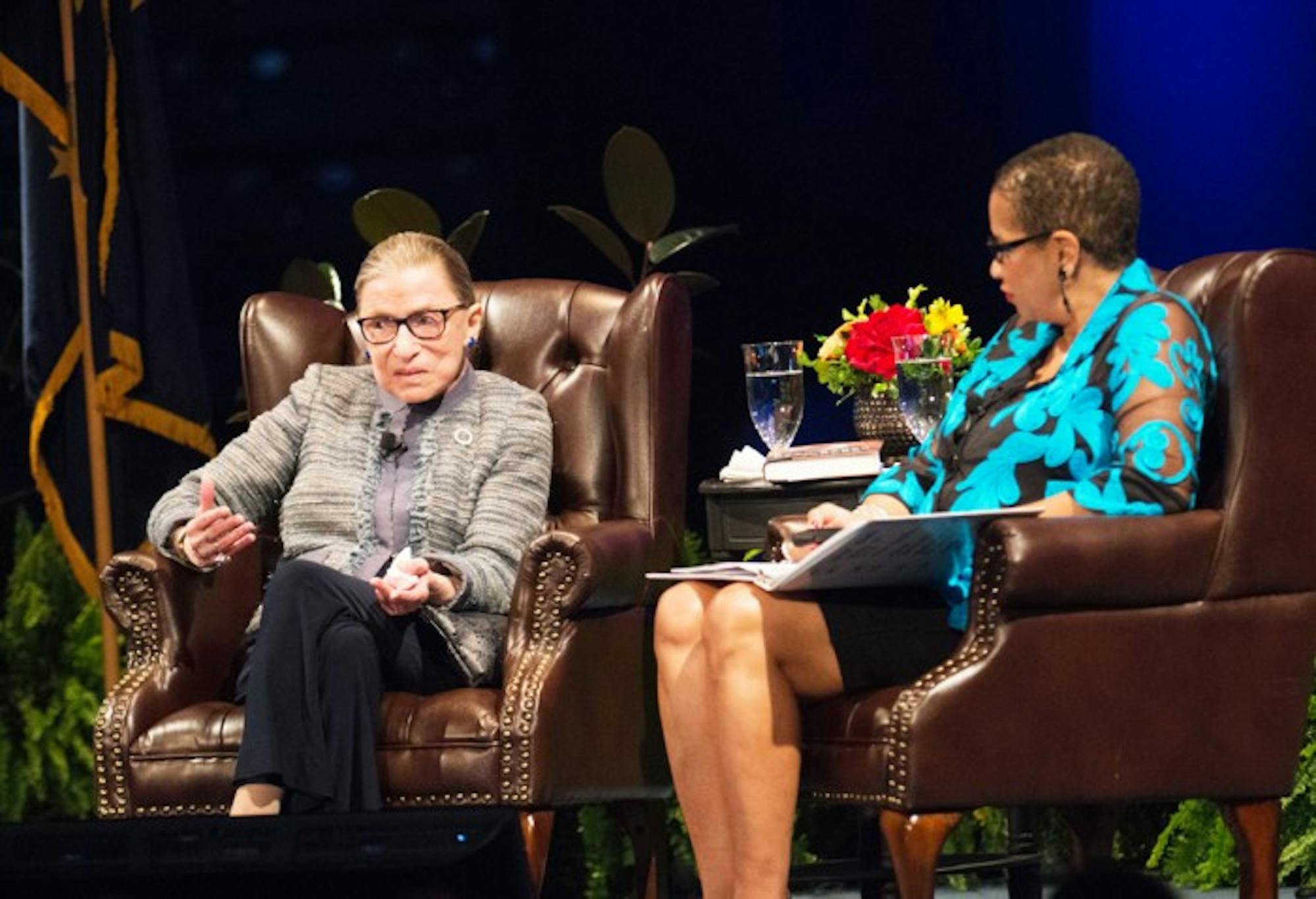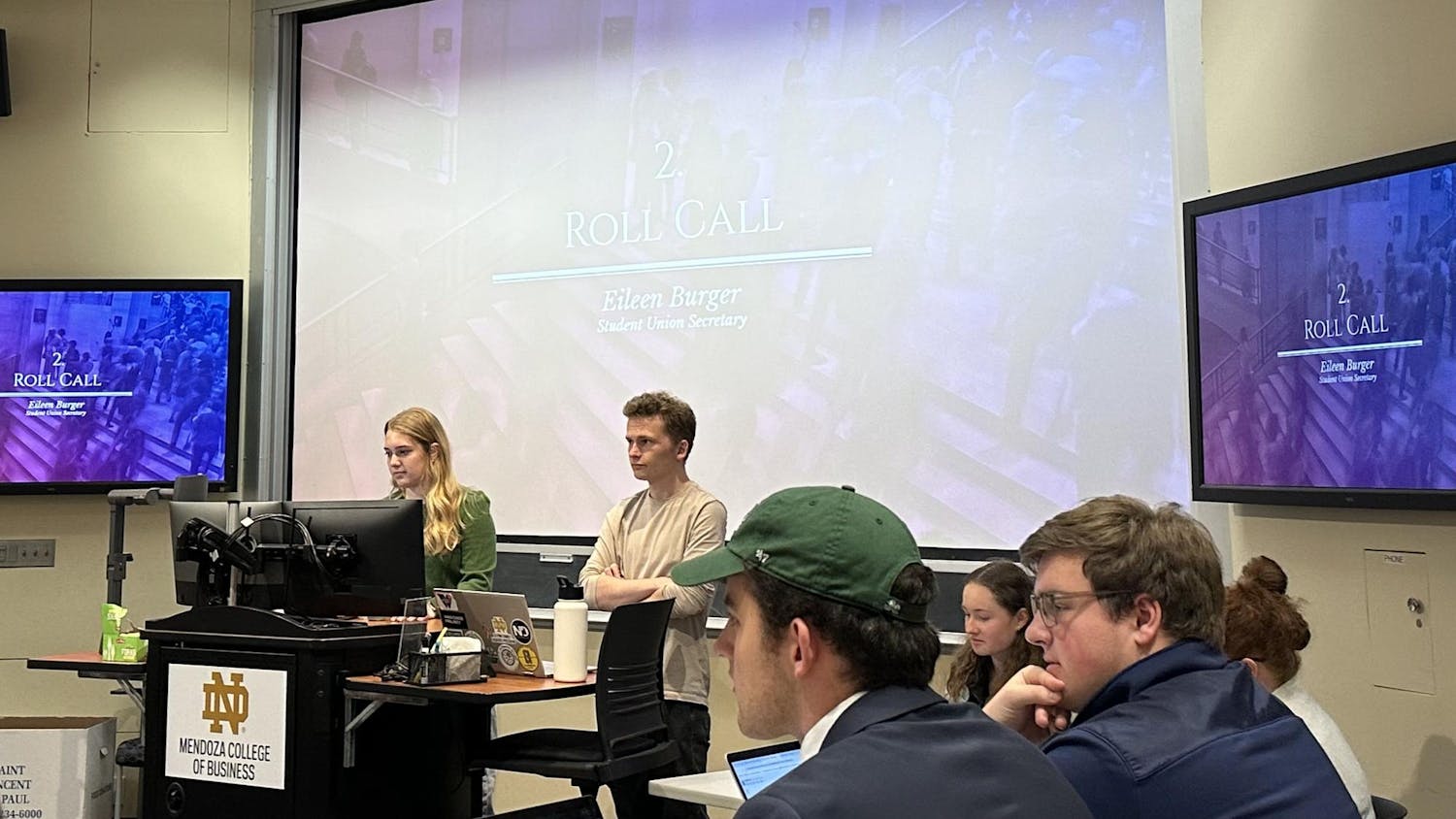
U.S. Supreme Court Justice Ruth Bader Ginsburg is fully aware that one of her nicknames is “Notorious R.B.G.”
“I do know where Notorious R.B.G. comes from,” Ginsburg said in a talk Monday night at Notre Dame. “It is from a now-deceased rapper, Notorious B.I.G., and when I heard about it, I said, ‘Oh, that’s wonderful, we have something terrific in common. We were both born and bred in Brooklyn, New York.’”
Later in the evening, moderator Ann Williams, a U.S. circuit judge for the 7th Circuit Court of Appeals and class of 1975 law school alumna, asked if Ginsburg was “Queen Ruth.”
“I’d rather be notorious,” Ginsburg said.
The conversation with the 23-year veteran of the Court, sponsored by the Office of the President, Notre Dame Law School and Notre Dame Student Government, explored a number of topics throughout the evening.
When Williams asked about some of her hobbies growing up, Ginsburg said she was a fan of the Nancy Drew books.
“Most of the books I read in school were Dick and Jane,” Ginsburg said. “Dick was active and Jane was in a pretty party dress, but Nancy Drew was a doer and an actor. Her then-boyfriend mostly did what she told him to do. And I liked that part.”
Ginsburg said her mother was always a major influence in her life.
“My mom repeated two things many times: be independent, and the other, be a lady,” Ginsburg said.
Being a lady meant Ginsburg should not waste time on unproductive emotions.
“A lady does not snap back in anger; she isn’t envious; she is a lady,” Ginsburg said. “That is, if an unkind word is spoken, it is as though she didn’t hear it.”
Ginsburg said some of her fondest childhood memories were those of reading with her mother.
“My mother was a voracious reader, and she communicated to me her love of reading,” she said. “She took me on weekly trips to the library. … She would leave me in the children’s section, get her hair done and come back, and I would have my five books to bring home.”
Ginsburg also admired her mother-in-law, who gave her a set of earplugs as a wedding gift.
“Just before the [wedding] ceremony, [my mother-in-law] took me aside and said, ‘I’d like to tell you the secret of a happy marriage,’” Ginsburg said. “What was the secret? It helps every now and then to be a little deaf.”
That was such good advice, Ginsburg said, that she uses it to this day with her colleagues in the Supreme Court.
“When an unkind word is unspoken, I tune it out,” she said.
Asked about her career path in life, Ginsburg said she considered being a teacher for a while but had an increasingly strong desire to become a lawyer. She enrolled in Harvard Law School in 1956, when her baby Jane was 14 months old.
“We had a wonderful nanny to take care of her,” Ginsburg said. “I came home at 4 p.m. when the nanny left, and from 4 p.m. to when Jane went to sleep, that was children’s time. We would sing silly songs and go to the park. … Then when she was asleep, I could go back to the books with a new energy.”
During her time in law school, Ginsburg’s husband — himself a Harvard law student of the class above her — was diagnosed with cancer and underwent chemotherapy.
“I had a good note-taker in every class [for him],” Ginsburg said. “His classmates and our classmates rallied around us to help us get through that trying time.”
When asked about how she goes about writing court opinions, she said she appreciates clarity and word economy.
“We labored over our opinions so that people reading them, first of all, would not have to read a sentence twice to understand what it meant; we tried to write as clearly and concisely as we could,” Ginsburg said. “It’s a lesson I’ve tried to teach my law clerks. I’ve put a 20-page limit on notes.”
Ginsburg said progress has been made in diversifying the Court since Jimmy Carter became president.
“I’ve been asked the question, when will there be enough [women on the Supreme Court]? … My answer is, when there are nine,” Ginsburg said. “It didn’t seem like there was anything wrong in all the years when the Supreme Court had only men.”
Former fellow Supreme Court Justice Sandra Day O’Connor was like a big sister to Ginsburg, Williams said. Ginsburg said O’Connor, who is a breast cancer survivor, was particularly supportive when Ginsburg went through her own bout of cancer.
“Sandra had — in the 1980s, she had breast cancer," Ginsburg said. “She had massive surgery; she was on the bench, hearing arguments nine days after her surgery. Sandra had set the model for me so I had to get back on the bench.”
O’Connor’s advice for Ginsburg was to undergo chemotherapy on Friday, recover over the weekend and be back at work on Monday.
“She didn’t waste any time feeling sorry for herself; she just did it,” Ginsburg said. “That positive attitude is what she communicated to me.”
Junior Sarah Tomas Morgan asked Ginsburg how the Court may be better served by a diversity of opinions.
“At the end of the day, a wise old man and a wise old woman will have the same judgement,” Ginsburg said. “But we bring to the table knowledge that others lack.”
When asked by sophomore Prathm Juneja how she prevents herself from pre-determining particularly polarizing cases before arguments are presented, Ginsburg said she looks around at her eight fellow justices.
“I think about how I would like it if they projected their preconceived notions onto their decisions,” Ginsburg said. “Being part of a multi-person bench prohibits you from trying to be queen, because you’re not.”
As for retirement, Ginsburg said she is out of her usual answers.
“I plan on staying as long as Justice [Louis] Brandeis stayed,” Ginsburg said. “Justice Brandeis, he was appointed when he was 60 and I always said I would serve as long as Justice Brandeis, but he retired at 83 so I can’t use that one anymore.
“My current answer is as long as I can do it full steam, and that means I have to take it year by year.”













